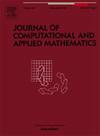The role of interface boundary conditions and sampling strategies for Schwarz-based coupling of projection-based reduced order models
IF 2.1
2区 数学
Q1 MATHEMATICS, APPLIED
Journal of Computational and Applied Mathematics
Pub Date : 2025-02-20
DOI:10.1016/j.cam.2025.116584
引用次数: 0
Abstract
This paper presents and evaluates a framework for the coupling of subdomain-local projection-based reduced order models (PROMs) using the Schwarz alternating method following a domain decomposition (DD) of the spatial domain on which a given problem of interest is posed. In this approach, the solution on the full domain is obtained via an iterative process in which a sequence of subdomain-local problems are solved, with information propagating between subdomains through transmission boundary conditions (BCs). We explore several new directions involving the Schwarz alternating method aimed at maximizing the method’s efficiency and flexibility, and demonstrate it on three challenging two-dimensional nonlinear hyperbolic problems: the shallow water equations, Burgers’ equation, and the compressible Euler equations. We demonstrate that, for a cell-centered finite volume discretization and a non-overlapping DD, it is possible to obtain a stable and accurate coupled model utilizing Dirichlet–Dirichlet (rather than Robin–Robin or alternating Dirichlet–Neumann) transmission BCs on the subdomain boundaries. We additionally explore the impact of boundary sampling when utilizing the Schwarz alternating method to couple subdomain-local hyper-reduced PROMs. Our numerical results suggest that the proposed methodology has the potential to improve PROM accuracy by enabling the spatial localization of these models via domain decomposition, and achieve up to two orders of magnitude speedup over equivalent coupled full order model solutions and moderate speedups over analogous monolithic solutions.
求助全文
约1分钟内获得全文
求助全文
来源期刊
CiteScore
5.40
自引率
4.20%
发文量
437
审稿时长
3.0 months
期刊介绍:
The Journal of Computational and Applied Mathematics publishes original papers of high scientific value in all areas of computational and applied mathematics. The main interest of the Journal is in papers that describe and analyze new computational techniques for solving scientific or engineering problems. Also the improved analysis, including the effectiveness and applicability, of existing methods and algorithms is of importance. The computational efficiency (e.g. the convergence, stability, accuracy, ...) should be proved and illustrated by nontrivial numerical examples. Papers describing only variants of existing methods, without adding significant new computational properties are not of interest.
The audience consists of: applied mathematicians, numerical analysts, computational scientists and engineers.

 求助内容:
求助内容: 应助结果提醒方式:
应助结果提醒方式:


